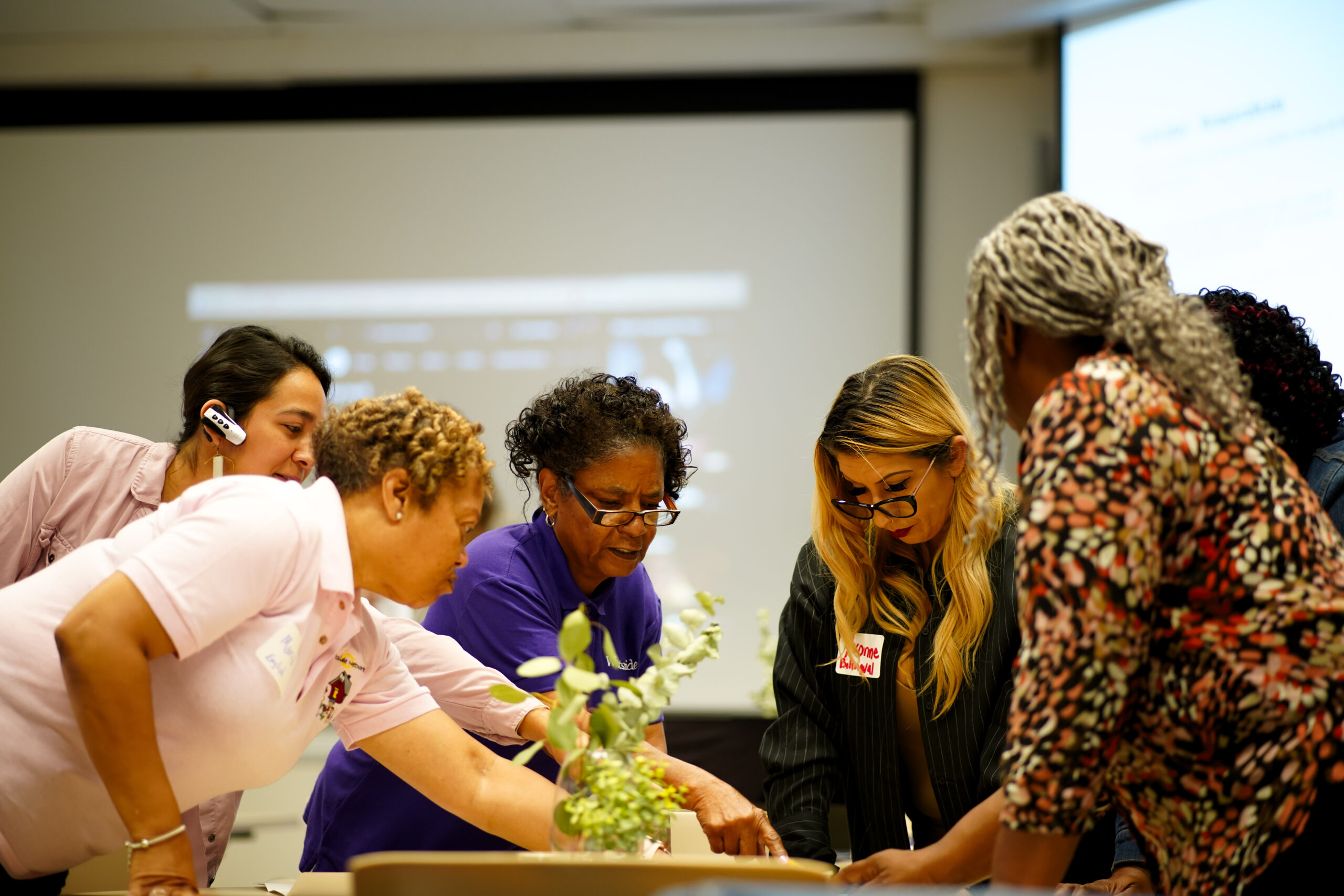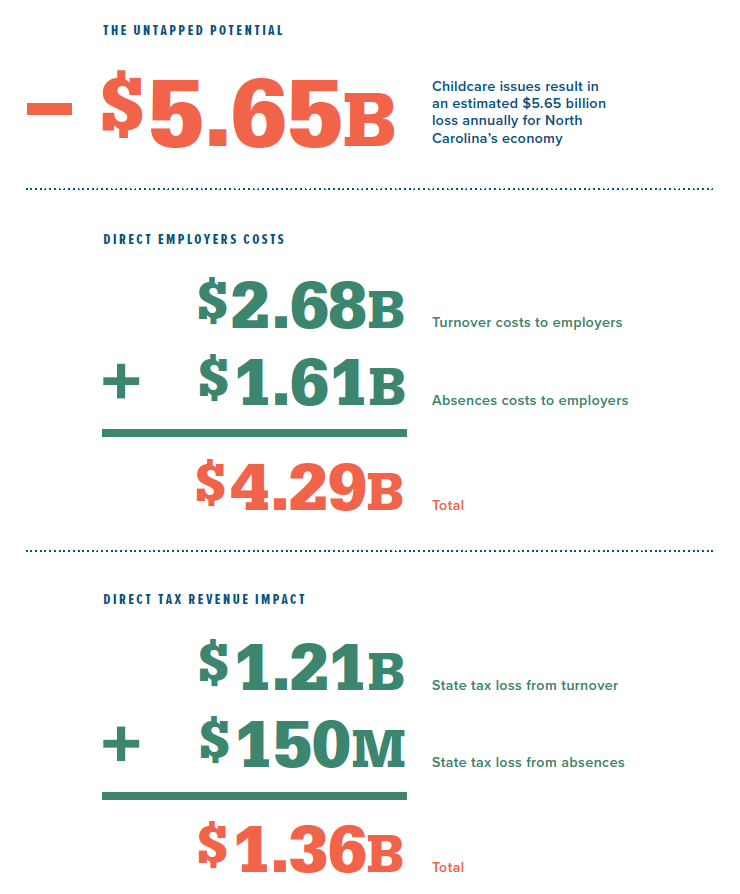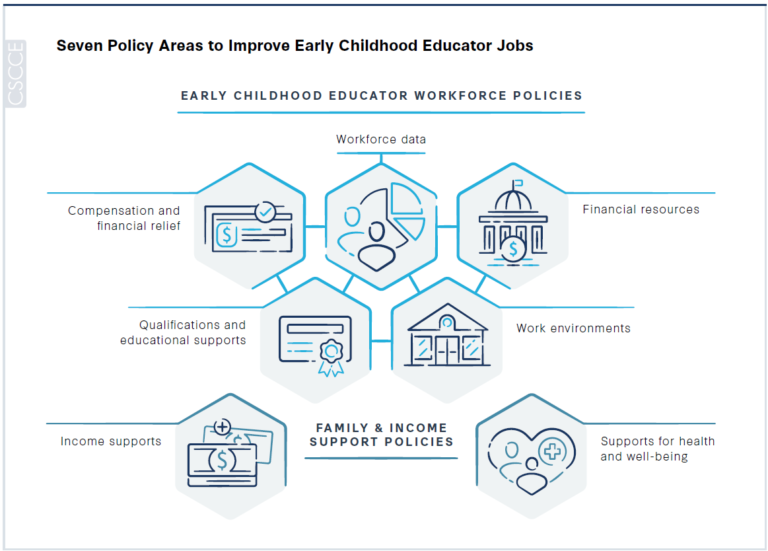By MDC’s Educational Equity Team
During the COVID-19 pandemic, when schools, workplaces, and restaurants shut down, the Care Economy[i] quickly became one of the most salient issues in American life. The Care Economy is the part of the economy that provides child care, elder care, disability care, and care for the sick. Care that is essential—whether paid or unpaid. For many people who have relied on this form of labor to balance work, education, and family commitments, the pandemic demonstrated just how essential our communities’ caretakers are in sustaining our lives.
“The child care coverage gap in North Carolina is not only a barrier to parents’ ability to participate in the labor force, but also a hindrance to the state’s potential for growth and success.”
Source: “Untapped Potential in NC: How Childcare Impacts North Carolina’s Workforce Productivity and the State’s Economy”, a report produced by the United States Chamber of Commerce Foundation, the NC Chamber Foundation, and NC Child
Prior to the pandemic, child care providers were already stretched thin, “making it work” with long hours and meager payment. Adapting to provide child care under new and more challenging conditions, many providers relied on retirement funds, federal stimulus money, or public assistance programs—if they could access it—to make ends meet. The Center for the Study of Child Care Employment found that 53 percent of child care workers or their family members were enrolled in at least one public support program, compared with 21 percent of the U.S. workforce as a whole.[ii] In the pandemic’s aftermath, we’ve seen the effects of child care providers’ economic precarity: fewer providers offer services and child care is harder to find and more expensive than ever.
Although the topic of child care has remained in the media, national conversations tend to overlook the system’s glue: home-based child care. Home-based providers offer child care out of their homes, serving a broad swathe of their communities. Early in the pandemic, they were the only reliable form of child care available. Some home-based providers operate as small businesses called Family Child Care Homes (FCCH) and meet complex licensing regulations. Others care for the children of their relatives, friends, and neighbors, offering Family, Friend, and Neighbor (FFN) care and may be legally exempt from licensing.
As noted by the First Five Years Fund and the U.S Treasury Department, 5.2 million providers cared for 12.3 million children under the age of 13 in their homes in 2019. Of the home-based child care providers:
- 91,000 were listed providers (i.e. licensed family child care home),
- More than 1 million were unlisted paid providers (i.e. nannies), and
- 4 million were unlisted unpaid providers (i.e. family or friends who may or may not live with the children they care for).
Home-based child care tends to be less expensive than its center-based counterpart, and it can offer flexible hours, making it a good fit for parents with a nontraditional work schedule. Crucially, home-based providers often come from the same culture as the families they serve—they may speak the same language, hold the same dietary restrictions, or practice the same religion. All these factors make home-based child care an essential piece of our child care infrastructure and a particular asset for working families, immigrant communities, and communities of color.
"The centers also don’t always accommodate the off schedules of families (e.g. if they work in a restaurant over the weekend). The [home-based] providers have this flexibility to offer care during these non-traditional hours.”
Network leader in MDC’s Home-Based Child Care Community of Practice
Despite their critical role in our country’s infrastructure, home-based child care providers face a variety of barriers. Licensed home-based child care providers self-reported their hourly wages as low as $2.58 in 2023, while some home-based providers are not paid at all.[iii] Our system also favors licensed, center-based child care—and anyone who falls outside those parameters tends to be stigmatized and undervalued.
“[Give] us the opportunity to have a say before you make laws and decide things. Let us speak freely and not feel like what we say will put our license in jeopardy, or if we speak against something, that you will come to our place and.… make something where it isn’t. Where I’m under the microscope because I spoke up.”
Home-based child care provider-leader in MDC’s Haven Program
Many home-based providers feel disrespected by the lack of recognition, support, and inclusion in decision-making that affects their operation, even if it is exempt from a license or when they try to obtain and maintain a license. However, the licensing process is expensive, onerous, and, in some cases, impractical. Moreover, licensed home-based child care requires enough revenue generation to cover operating costs and personal living expenses while remaining affordable enough for the families in the communities they serve—a business model widely considered a market failure.[iv]
When home-based providers face economic precarity, it stretches our social infrastructure to the point of breakage. Some providers may reduce their hours because they have a second (or third) job to pay the bills, limiting child care options for families. Some may need to raise their rates, likely pricing out some or all of the families they serve. Increasing enrollment can be nearly impossible since staying within regulatory bounds would require becoming licensed or, if already licensed, making major renovations or moving homes amidst a national housing crisis.
With all this stake, many providers simply leave the profession entirely. Across North Carolina, the number of licensed home-based providers in operation is declining rapidly, representing 85% of all child care closures in the state since February 2020.[v] This reality is pushing more families to rely on license-exempt care provided by friends, family members, and neighbors, both by choice and by necessity.
“A lot of providers won’t be able to sustain – they are losing their homes, can’t pay their mortgage, don’t have food. This is why we are closing doors, they are pushing us out by this way.”
Network leader in MDC’s Home-Based Child Care Community of Practice
For immigrant families, working families, families of color and all of us, the widening child care gap due to providers’ economic insecurity is a frightening reality. Not only do families lose quality care options for children, but the state loses out on economic potential. Each year, child care gaps are estimated to cost North Carolina’s economy $5.65 billion in lost economic activity.[vi]
Across the state, providers and advocates are working for change. MDC facilitates two networks: a community of practice of home-based child care networks, and Haven, a policy and advocacy leadership development program of home-based child care providers. These leaders and their allies are advocating for reforms that would ensure dignity and economic security for home-based providers in North Carolina. This includes reforming the licensing system, making it less burdensome without compromising necessary quality measures. It also makes it possible for people to take care of children in their community with more flexibility and support than the law currently allows.
Advocates are also pushing for services to be offered in multiple languages to meet the diverse needs of providers and families in our state. State and local governments can help by offering salary supplements, increased access to child care subsidy, access to support and educational services, and start-up grants to all home-based providers, both licensed and license-exempt. All these efforts help to ensure the viability of the critical services home-based child care providers offer our communities.
“Who can speak for us except us?.... Giv[e] us a seat at the table when decisions are being made, when rules and reg[ulation]s are being set out. Find out how we feel about it.”
Home-based child care provider-leader in MDC’s Haven Program
For too long, the providers we rely on have been undervalued, mistreated, and subject to a system that doesn’t treat them with the dignity they deserve: most fundamentally, a stable living that reflects the incredible importance of their work. When we invest in the economic security of all child care providers, especially home-based providers, we acknowledge a truth that we don’t state nearly enough: Child care and child care providers make opportunity possible—for our children, for our families, and for entire communities.
Seven Policy Areas to Improve Early Childhood Educator Jobs
MDC’s Educational Equity Team engages with changemakers and communities across the South that are transforming educational practices, policies, and systems from prenatal through post-secondary settings to ensure that all children thrive. Insights in this story are drawn from our work with the Home-Based Child Care (HBCC) Community of Practice and HBCC Haven, a leadership program for home-based child care providers.
[i] Note: MDC is using the term “Care Economy” because it is understood and used by much of the audience of this report. We choose not to position the Care Economy and its workers as “invisible work” because we want to impart that this work is essential, important work that is at the forefront of our economy. However, we believe there may be a better term for the set of workers that provide foundational health, educational, and domestic care for our families. As a result, we will do further research to understand how to frame this work in the future.
[ii] Ullrich, Rebecca, Katie Hamm, and Rachel Herzfeldt-Kamprath. “Underpaid and Unequal: Racial Wage Disparities in the Early Childhood Workforce” (August 2016). Center for American Progress. https://www.americanprogress.org/article/underpaid-and-unequal/
[iii] Child Care Services Association. “Working in Early Care and Education in North Carolina,” (February 2024). https://www.childcareservices.org//www/wp-content/uploads/Working-in-Early-Care-and-Education-in-North-Carolina2023-Workforce-Study.pdf.
[iv] Guevara, Hannah. “Treasury Dept. Report Highlights Market Failures in America’s Child Care System and How Build Back Better Can Help,” (September 24, 2021). First Five Years Fund. https://www.ffyf.org/resources/2021/09/treasury-dept-report-highlights-market-failures-in-americas-child-care-system-and-how-build-back-better-can-help/.
[v] Dukes, Katie. “The number of licensed child care programs in North Carolina continues to decline,” (July 30, 2024). EdNC. https://www.ednc.org/07-30-2024-licensed-child-care-programs-north-carolina-continues-decline/.
[vi] US Chamber of Commerce Foundation. “Untapped Potential in NC,” (2024). https://ncchamber.com/foundation/untapped-potential-report/.
Banner image: Members of MDC’s Home-Based Child Care (HBCC) Community of Practice collaborate on an activity in fall 2023.





